by Paul Dufresne
In Part 4 I explained how Endotapping could improve the quality of the walk and trot. The tapping improves the movement by causing the neurohormonal release of endorphins and a deeper relaxed state in the horse.
The canter is trickier due to the speed of the gait and the leader will have to move out more energetically themselves to join the horse. If a leader does not have a good grasp of controlling the feel good in a horse at walk and trot the canter development is not recommended. Don’t get a horse in an adrenalin surge without having a good cue to bring them back quickly. You don’t need a full blown excite cycle too early in the process to test how well you have developed this control.
Before you tackle the canter you need to have good relaxation cues through tapping, correct bend on a circle, a good head down cue and also suppleness at the poll where the head hangs plumb or vertical. You should be able to get the horse to do a nice walk with over-reach which means the horse should be able to go past its front foot print with the hind leg on the same side (see Endotapping Part 1).
You should have calm transitions from walk to trot with few physical aids such as touching the horse with a whip, clucking, slapping your leg, etc. You should also be able to regain the walk by taking your energy down to a slower walk yourself, with maybe a hint of elevating the lead line to suggest slowing and engaging the hindquarters.
You should also be able to ask your horse to transition from a relaxed long and low jog to a more engaged trot while maintaining a relaxed poll. Through all of this the horse must be balanced and have as much weight on the outside shoulder as the inside. If you don’t have fluidity and balance the canter will not be good. If your horse leans in on a smaller circle it may panic if you ask for more energy in this unbalanced state.
I ask for the canter by first asking the horse to “quarter” or do a mini sweep. I elevate the lead line until the horse moves its inside hind across and under itself and shifts weight to the outside shoulder. When the horse does this balanced and engaging step of the hind quarter, I then add the energy for the canter. I allow the horse to go straighter as it tries to pick up the canter. This helps the horse remain balanced and calm. What is important at first is that the horse makes an attempt to canter - not necessarily actually canter.
I always tap my horse into a relaxed frame while moving so I have the softness of their poll. I then mini sweep while elevating the lead line to engage the hindquartering while balancing them. I then look up and add my energy UP & FORWARD into the canter. It shouldn’t take many tries before the horse picks-up the correct lead. If the horse gets excited I may only ask 3-10 strides before regaining the relaxed state at the walk. Most horses get it in very short order, however, if a horse has draft in them or they are gaited, or if a horse has been taught to brace this may require more effort and time to develop.
Don’t panic if the horse gets excited or picks up the wrong lead… just stay relaxed and bring the horse back to a happy place in a downward transition and try again after re-suppling. If the horse picks up the lead and gets a bit racy because it is falling into the circle, elevate the rein/leadline and do a bit of a mini sweep to engage their hindquarters and rebalance on the outside shoulder.
I only ask the horse to stay in the canter if the horse remains balanced. The horse will visibly show you when it is ok in the canter even on a smaller circle. Working from a large circle to a smaller circle helps maintain proper bend and encourages to the horse to slow down as it is much too difficult to sustain speed/balance on the small circle. If you keep applying the mini sweep any time a horse leans in, you can often get a very nice controlled canter in 1-10 sessions depending on your ability. Remember it is not a contest of speed. Do whatever the horse tells you it needs to get comfortable in the canter, and repeat it calmly if it isn’t perfect right away. The pressure we put on horses for making a mistake on the lead is so often what causes them to keep making mistakes.
If your horse can do a decent canter on the circle, travel beside them in a very strong walk and tap in zone 1 in the rhythm of the canter you would like them to assume. The horse should start to relax even further into a soft lope or slow canter and nicely balance.
I often have people ask if working on a small circle is detrimental to the horses’ joints and limbs. The answer is the opposite when it is done correctly. You cannot not improve bend without creating bend and you cannot improve balance without actually putting the horse in a position that it has to balance. The key is to relax the horse and make it easier for them. An anxious horse will always have more difficulty bending and balancing because anxiety causes negative counter-flexion or inverting of the top line.
The really cool thing about achieving this well in-hand before riding, is that it lessens the learning curve under saddle later without ever risking the riders or the horse’s well being.
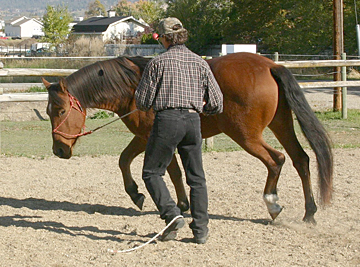
Easy tapped long and low at the trot.
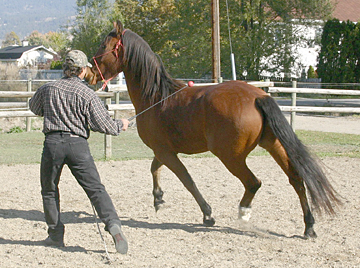
Easy is elevated to the canter cue.
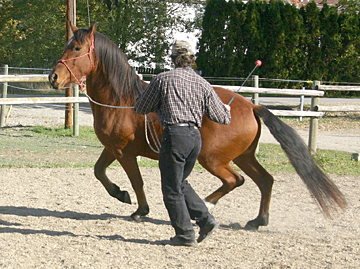
Easy energized, elvated and ready to canter.
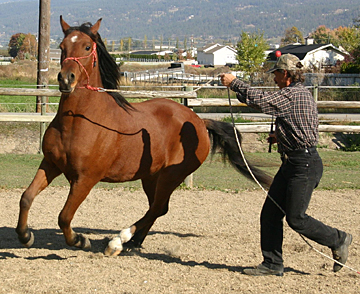
Easy is elevated and now cantering.
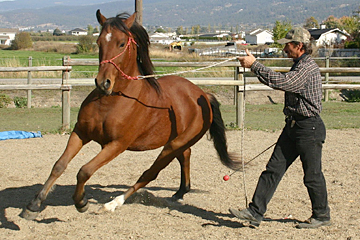
Easy settling in an almost balanced canter after a few strides. Later I'll tap him while cantering with a slightly longer whip.
trainers and clinicians modify techniques to suit their needs, and the needs of their students - both human or equine. This
technique, when combined with shape control and Natural Horsemanship, I have found to be an exceptional
way to lead a horse and facilitate a very healthy partnership.